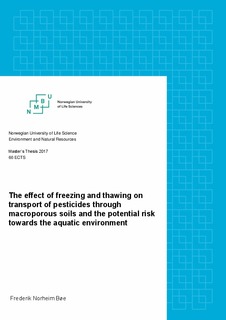| dc.description.abstract | Pesticides and their metabolites can leach rapidly through agricultural soils through macropores, be transported further into surface waters and potentially cause negative effects in aquatic organisms. Cold climate with freezing and thawing of soils can affect the leaching. The transport of pesticides during winter and early spring have however received little attention and there is a need to assess the impact of cold climate conditions to get a better understanding of the risk of contamination.
The objective of the work has been to provide knowledge on how freezing and thawing affects leaching of pesticides through agricultural soils with well-developed macropore structures. To obtain information of water transport in the soil, bromide was included as a non-reactive tracer. Ten undisturbed soil columns were collected from an agricultural soil known to contain macropore structures in Ås, Norway. The mobile herbicide MCPA and the tracer bromide was applied to all soil columns and five soil columns were frozen at -3 ° C while five where stored cold at +3 ° C. During the experiment the soil columns were subjected to four irrigation events. The leachate was collected continuously during the leaching experiment and concentration of MCPA and bromide were measured for both frozen and unfrozen soil columns, and used to assess the effects of four consecutive freeze-thaw cycles on pesticide and bromide leaching through macroporous soils.
The results showed that there was more bromide leaching from the frozen than the unfrozen soil columns during the first irrigation, while the leaching from the unfrozen soil columns was higher during later irrigation events. The total amount of bromide leached through frozen soil columns after four irrigations varied between 35.0 % and 43.1 % of the applied amount, but between 48.1 % and 72.3 % through the unfrozen soil columns. The major part of the bromide was transported through the frozen soil columns during the 1st and 2nd irrigation, while during the 3rd irrigation through unfrozen soil columns. The earlier arrival of bromide from frozen soil columns indicated a faster transport of bromide through the frozen soil columns. However, there was no significant difference between the frozen and unfrozen soil columns during the 1st and 2nd irrigation. Compared to bromide a different trend in the proportions of leaching were observed for the transport of MCPA, were the total amount of MCPA leached after four irrigations was significantly higher from frozen than unfrozen soil columns. Total amount of MCPA leached of the applied amount after four irrigations varied between 16.4 % and 32.9 % from frozen soil columns and between 0.1 % and 0.8 % from unfrozen soil columns. The leaching of MCPA were largely transported through the frozen soil columns during the 2nd and 3rd irrigation and during the 1st irrigation through unfrozen soil columns. The leaching of MCPA through unfrozen soil columns might be explained by the expected air-filled macropores caused initial macropore flow. The increased total amount of MCPA leached through frozen soil columns compared to unfrozen soil columns occurred although the total leachate was lower. This could be explained by the freezing and thawing of the soil caused efficient transport of MCPA through bypassing sorption sites. Thus, results show that freezing and thawing contribute to increased leaching of MCPA. Furthermore, it is essential to understand underlying mechanisms to reduce the potential risk in the future with the expected increase in winter cereal productions and use of pesticides in the late autumn. | nb_NO |

